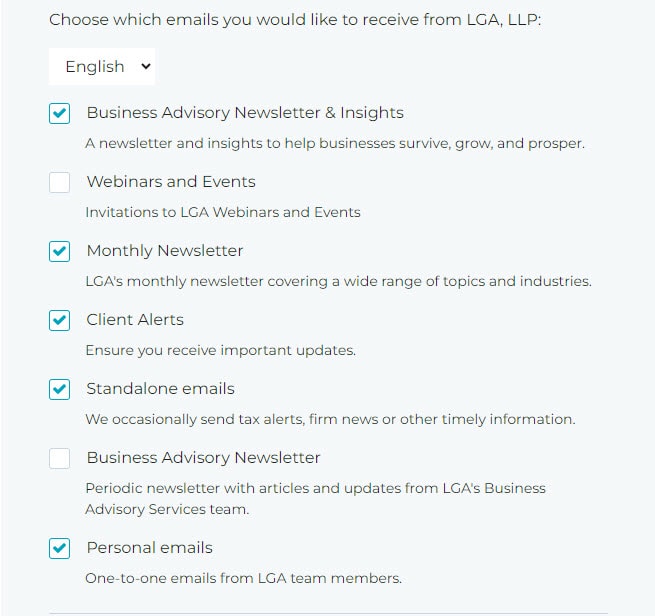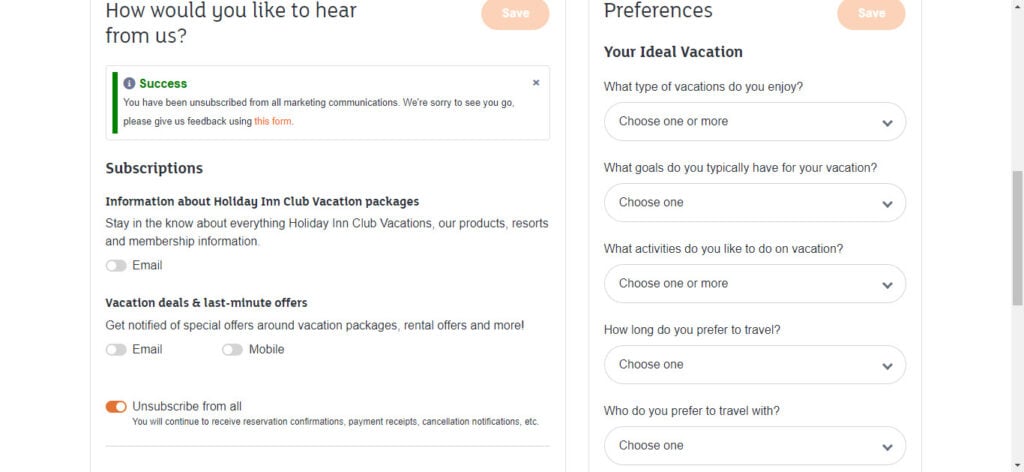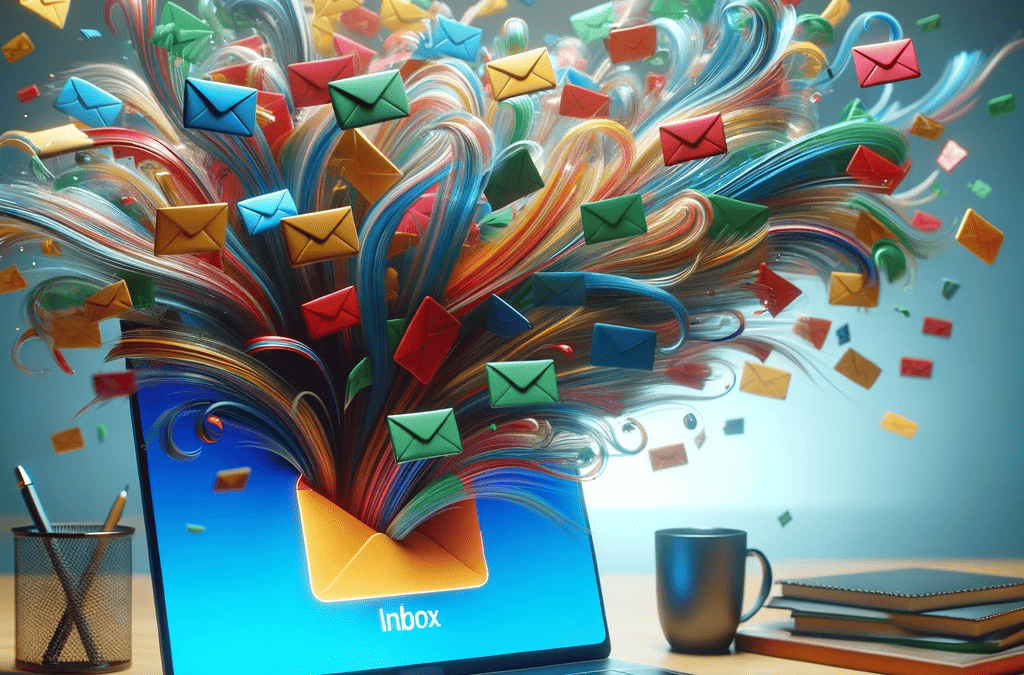My husband Dan had an anguished look a couple of weeks ago. He asked me a question that tugs at the heartstrings of any marketer.
“How do I let a company I want to be in touch with know they are sending me too many emails?”
Dan is an investment advisor. Investment funds flood his inbox with marketing emails.
I felt Dan’s pain on 2 fronts. First, as a recipient. I’ve been trying to tame my inbox too.
Second, as a marketing consultant. It’s hard to watch good brands test the limits of their email subscribers’ permission, frustrating them and endangering their relationship with them.
Sanity Savers for Email Recipients
If you find yourself with the same question as Dan – wondering how you can stay in touch with a company you like but not get overwhelmed with their emails – I’ll tell you what I told him.
Each marketing email you receive should have a link to manage your preferences. Often you can find it at the bottom of the email, near the unsubscribe link.
Here’s the bottom of a marketing email I got from BodyGuardz, a company that makes cell phone screen protectors:

You can see the “Manage Preferences” option in the lower right-hand corner, above “Unsubscribe.”
Like many companies, the preferences turn out to be my contact information, but there was also an option to “Snooze emails for 3 weeks.” They thoughtfully put that as a direct link in the bottom of the email as well.
Smart companies, especially those with multiple newsletters and marketing campaigns, will give you more specific options.
When I went to manage my preferences at my account’s firm, this is what I saw:

The accounting firm gets points for letting me choose what to receive.
Their inclusion of “Business Advisory Newsletter & Insights” and “Business Advisory Newsletter” confused me though. What’s the difference?
Holiday Inn began sending me a barrage of emails after I started staying regularly at one of their New Jersey locations close to my parents’ residence. Their options impressed me when I went to unsubscribe.
They had 2 marketing email options with descriptions that made clear what I would receive. A button below those options provided a one-click unsubscribe from all marketing emails.
Holiday Inn also took the opportunity in the right-hand column to ask about my vacation preferences.
They gained my admiration for their options, but lost me as a subscriber. Their proximity makes them my best option when visiting my parents, but I’m not interested in Holiday Inn vacations.

I’m happy to report that Dan found the manage preferences link. His investment fund companies have not made it easy to stem their email tide, however.
Some companies offer only an unsubscribe option (required by law). At that point you can try to contact a favored company and see if you can work the frequency down through customer service.
Many of us just unsubscribe in that situation. I do.
During the holiday season, retailers who email occasionally during the first 10 months of the year use the holidays as an excuse to inundate us daily.
The flood of emails has gotten so bad that I now hear revised lyrics when Andy Williams sings…It’s the MOST un-sub-scribe time of the year!
It’s not just Andy Williams singing that revisionist song in my head. Unsubscribes soar during November and December.
According to Jay Schwedelson, CEO of Outcome Media, people aren’t just unsubscribing because they are jaded from email volume. They are also reassessing what they want.
So how do you keep your company top-of-mind without losing a ton of subscribers?
Respect Your Recipients to Reduce Your Unsubscribes
As a business owner sending emails, I urge you to remember your feelings as a recipient.
If you don’t like getting daily emails from any one company, then don’t send that many yourself!
Like your parents said, treat others as you’d like to be treated.
It is hard to reconcile that golden rule with the benefits of marketing emails, especially if your business seasonality means the holidays make your year (I see you retailers).
Long-time readers of this newsletter and savvy marketers know email marketing generates great return on investment, $36 for every $1 spent.
But sending more emails isn’t always better.
You know what is always better? Sending better emails.
Here are 6 tips I picked up at 2 conferences this fall, MarketingProfs B2B Forum and GURU 2023, to help you improve your marketing emails:
1. Send from a person, not a company
With the volume of email we manage and spam infesting our inboxes, the first thing a recipient looks at is the email sender.
Recipients trust emails sent from a specific person more than a company.
Having your name on emails you send gives your recipients a chance to recognize you and increases the chance they’ll open them.
A company name is less personal, less likely to be trusted, and more likely to go unopened.
2. Protect your sender reputation
As senders, our first hurdle is to land our emails in our subscribers’ inboxes as opposed spam, junk, or promotions folders.
For several years, this meant ensuring your subject line avoided controversial or spammy terms.
Per Jay Schwedelson, the subject line no longer determines whether an email goes to the junk folder. Sender reputation does.
I’ll spare you the technical aspects of sender reputation (DKIM and DMARC) – your tech help can address that.
Major email services now look at the relationship your email address has with the recipient’s address to determine your sender reputation. Have you had an email volley?
To that end, when you send an email, entice your subscribers to reply. You can offer them something and ask them to “reply with” a code or a word to get it.
For Dan’s investment funds, the offer might be market updates or fund manager perspectives. For another example, see the end of this article. 😉
Schwedelson reports emails using “reply with” see a 400% increase in response rate.
Replies teach networks you are a legit email sender and increase the chance your email will reach recipients’ inboxes by 75%.
3. Rock your subject line
After noting the sender, your subscriber will look at the subject line to decide to read, save, or delete your email.
Short subject lines entice more opens. Jay Schwedelson says subject lines with fewer than 20 characters fare best, increasing open rates 19% for business-to-business emails, 24% for consumer emails.
Putting the number of minutes to read in the subject line increases open rates 20%.
Nancy Harhut, Chief Creative Officer of HBT Marketing and a direct and digital marketing expert, advises putting 1 word of the subject line in all caps for emphasis. Rhyming subject lines also help open rates.
4. Don’t abuse your list
Choose your email frequency carefully. Don’t flood your subscribers’ inboxes.
Besides the annoyance factor and higher likelihood of unsubscribes, having many unopened emails can hurt your sender reputation. That will make future email delivery more challenging.
Remember: your subscribers’ permission is precious and provides a direct line for you to continue your relationship.
How often should you send? There isn’t a blanket right answer.
GetResponse reports the average open rate for all newsletters in 2022 as 27.9%. (Thanks to you, my fabulous readers, my Varsity Marketing newsletter beats that handily. My 2023 open rates have ranged from 67%-81%.)
The typical open rate for once-a-week newsletters was 38.21%, per GetResponse. That drops to about 30% for those sending 4-6 times per week.
You can find typical open rates for different industries and more on email frequencies here.
5. Honor unsubscribes fast
Nothing irks a former subscriber like continuing to receive unwanted emails.
Companies that drag out the unsubscribe process not only generate ill will, but may find themselves locked out of other subscribers’ inboxes in the future.
According to Guy Hanson, Vice President, Customer Engagement at Validity, Inc., Google and Yahoo have announced new rules to stem spam and will be enforcing them beginning in February 2024.
While Google has said the rules will apply to bulk senders – those sending 5,000 or more emails daily – Hanson advises everyone to heed the rules or risk relegation to the promotions folder.
The rules include:
- Have an unsubscribe header or an unsubscribe option visible in the body of the message, preferably at the top.
- Require only 1 click to unsubscribe.
- Honor all unsubscribe requests within 2 days.
Make sure your emails meet these criteria.
As we discussed above, allowing subscribers to manage their preferences can help you stay in touch with recipients who want fewer or only specific emails. If you have multiple newsletters or email campaigns, offer that option.
(Also, Google is going to delete all gmail accounts that have been inactive 2 years or more. You may see some inactive gmail recipients’ emails bouncing as a result. If they haven’t opened an email from you in the past year, taking them off your list will improve your sender reputation.)
6. Plan for dark mode
This last tip took me by surprise. My only experience with dark mode has been when consulting GPS at night.
Pierce Ujjainwalla, Co-Founder and CEO of email service provider Knak, reported that 88.6% of phone users have been looking at emails in dark mode.
He warned that those of us using black font in emails will mean that our readers can’t see our text in dark mode.
I’ve not delved deep into this yet, but it’s got my attention. My new friend Jim McLeod conducted a LinkedIn poll about dark mode use and found 66% of the 90 people who voted preferred dark mode.
I hope you’ve found these 6 tips helpful. If you implement these recommendations in your marketing emails, you will see better open and response rates.
Now I would like your help, please.
Do you read your emails in light or dark mode?
Please comment below with light or dark to let me know. I’ll share the results in my January newsletter.
Thank you! 😊
***
Just for Fun
Julia Child with a potato dish that doesn’t go her way (1 minute, 40 seconds), h/t Jillian Hess
While it won’t reduce your emails, SNL’s “Leave Me A Lurn” will help in other ways. – SNL (2 minutes, 29 seconds)
See what was trending in Google’s Year in Search for 2023 (2 min read), plus video on most searched over Google’s 25-year history (3 minutes, 48 seconds) h/t Dave Pell
Enjoy!
If you liked this post, you’ll love the next one. Get future posts right to your inbox by clicking here.


Hello Evelyn,
My pixel 8 pro switches the font color on my phone when I go in dark mode. So if the font is black and my background changes, the phone changes my font to white.
Happy Holidays!
Anne J
Good to know, Anne. Thanks for chiming in. Happy holidays to you too! Do you prefer dark or light mode when you read emails, or are you using both?
I don’t use dark mode. It bugs my eyes a bit.
Thanks for letting me know, Julie. I appreciate your voting on the light v. dark mode matter and letting me know your reason.